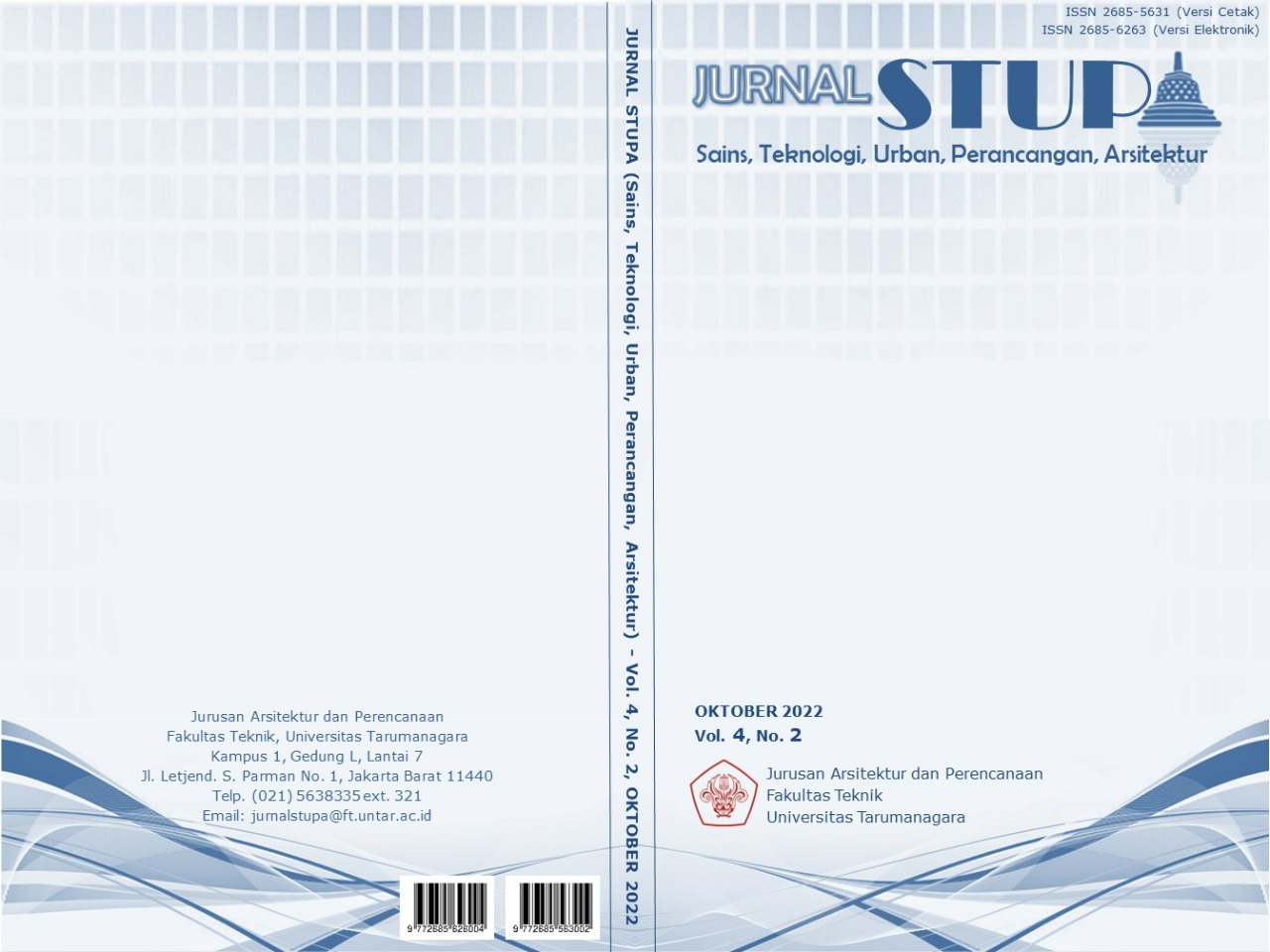MENGHIDUPKAN KEMBALI RUANG SOSIAL PINANGSIA
Main Article Content
Abstract
The strategic location of the area makes Pinangsia a center of shopping and trade. The rapid physical development of the city can be seen in the Pinangsia Region, which is why many social spaces are lost. This makes the development process and the lives of city residents increasingly uncertain. The physical condition of the city that can lead to environmental quality degradation. To find out what factors influence the fading of social space in an area, urban acupuncture methods are applied to identify and analyze the site in terms of history and the degradation that occurred. By using the daily design method, the application of this method is applied by reading the social space formed in society so that it can direct the architecture to become an inclusive one. This is done with a participatory approach, namely conducting field surveys and seeking stories from sources. The Pinangsia area is one of the areas experiencing degradation in terms of physical structure and social space. To rebuild the lost layers of the area, a third architectural platform is needed to restore the social space that has begun to fade in accordance with the development of the City of Jakarta. The space that we want to present is a third place where it can be a gathering point for the surrounding community and can be a generator for the Pinangsia Region. The container from this third place will be supported by community hub and transit hub programs. By presenting Pinangsia Connect, dynamic spaces can be accessed by all residents, and connected to the surrounding environment. By presenting a third place in this area as well, it is hoped that it can revive the social space that has long faded and re-attract the local community.
Keywords: Daily Life; Degredation; Third Place; Urban Acupuncture
Abstrak
Letak kawasan yang strategis membuat Pinangsia menjadi salah satu pusat pertokoan dan perdagangan. Pesatnya pembangunan fisik kota dapat terlihat pada Kawasan Pinangsia, yang mengakibatkan mengapa banyak ruang sosial menjadi hilang. Hal ini membuat proses pembangunan dan kehidupan warga kota menjadi semakin tidak menentu. Kondisi fisik kota yang berantakan mengakibatkan terjadinya degradasi kualitas lingkungan. Untuk mengetahui faktor apa yang mempengaruhi pudarnya ruang sosial suatu kawasan, diterapkan metode urban akupuntur untuk mengidentifikasi dan menganalisis tapak dari segi sejarah dan degradasi yang terjadi. Dengan menggunakan metode desain keseharian, penerapan metode ini diterapkan dengan membaca ruang sosial yang terbentuk dalam masyarakat sehingga dapat mengarahkan arsitektur menjadi suatu yang inklusif. Hal ini dilakukan dengan pendekatan partisipatif, yakni melakukan survey lapangan dan mencari cerita dari narasumber. Kawasan Pinangsia merupakan salah satu kawasan yang mengalami degradasi secara struktur fisik dan ruang sosial. Untuk membangun kembali lapisan yang hilang dari kawasan ini dibutuhkan wadah arsitektur third place untuk mengembalikan ruang sosial yang mulai pudar sesuai dengan perkembangan Kota Jakarta. Ruang yang ingin dihadirkan adalah sebuah third place dimana dapat menjadi titik kumpul bagi masyarakat sekitar dan dapat menjadi generator bagi Kawasan Pinangsia. Wadah dari third place ini akan didukung dengan program community hub dan transit hub. Dengan menghadirkan Pinangsia Connect, ruang dinamis dapat diakses oleh semua penghuni, dan terhubung dengan lingkungan sekitar. Dengan menghadirkan third place pada kawasan ini juga, diharapkan dapat menghidupkan kembali ruang sosial yang sudah lama pudar dan kembali menarik masyarakat setempat.
Article Details

This work is licensed under a Creative Commons Attribution-NonCommercial-ShareAlike 4.0 International License.
This work is licensed under a Jurnal Sains, Teknologi, Urban, Perancangan, Arsitektur/ STUPA Creative Commons Attribution-NonCommercial-ShareAlike 4.0 International LicenseReferences
Amar. (2009). Identitas Kota, Fenomena, dan Permasalahannya. Jurnal Arsitektur FT Untad, Jurnal ruang: Vol. 1 No. 1
Butler S., et al. (2016). “Third Places” as community builders. Diakses pada 12 Februari 2022. https://www.brookings.edu/blog/up-front/2016/09/14/third-places-as-community-builders/
Lerner, J. (2014). Urban Acupuncture. Washington, DC: Island Press.
Lynch, K. (1960). The Image Of The City. The MIT Press, Cambridge.
Oldenburg, R. (1999). The great good place: Cafes, coffee shops, bookstores, bars, hair salons, and other hangouts at the heart of a community. Da Capo Press.
Oldenburg, R., & Brissett, D. (1982). The Third Place. New York: Palgrave Macmillan.
Setiawan, T. (2019). Sekelumit Tentang Pinangsia. Diakses pada 5 Februari 2022. https://jernih.co/moron/sekelumit-tentang-pinangsia/
Susanto A. (2020). Peta Metode Desain. Universitas Tarumanagara : Jakarta.
Wardhana A. (2021). JAKARTA: Sudut-Sudut Pinangsia. Diakses pada 5 Februari 2022. https://aryawardhana.id/2021/10/26/jakarta-sudut-sudut-pinangsia-part-1/
Yatskiv, I. dan Budilovich E. (2016). A comprehensive analysis of the planned multimodal public transportation HUB. Elsevier.
Zinoski, M. etc. (2017). Transportation Hub-Kumanovo, South East European Journal of Architecture and Design Volume 2017.



